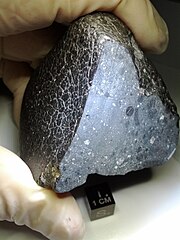Martian meteorite
| Martian meteorite (SNC meteorites) | |
|---|---|
| — Clan — | |

Martian meteorite EETA79001, shergottite
|
|
| Type | Achondrite |
| Subgroups |
|
| Parent body | Mars |
| Total known specimens | 132 as of 9 March 2014[update] |
 Martian meteorite NWA 7034, nicknamed "Black Beauty," weighs approximately 320 g (11 oz). |
|
A Martian meteorite is a rock that formed on the planet Mars and was then ejected from Mars by the impact of an asteroid or comet, and finally landed on the Earth. Of over 61,000 meteorites that have been found on Earth, 132 were identified as Martian as of 3 March 2014[update]. These meteorites are thought to be from Mars because they have elemental and isotopic compositions that are similar to rocks and atmosphere gases analyzed by spacecraft on Mars. On October 17, 2013, NASA reported, based on analysis of argon in the Martian atmosphere by the Mars Curiosity rover, that certain meteorites found on Earth thought to be from Mars were indeed from Mars.
The term does not refer to meteorites found on Mars, such as Heat Shield Rock.
On January 3, 2013, NASA reported that a meteorite, named NWA 7034 (nicknamed "Black Beauty"), found in 2011 in the Sahara desert, was determined to be from Mars and found to contain ten times the water of other Mars meteorites found on Earth. The meteorite was determined to have formed 2.1 billion years ago during the Amazonian geologic period on Mars.
By the early 1980s, it was obvious that the SNC group of meteorites (Shergottites, Nakhlites, Chassignites) were significantly different from most other meteorite types. Among these differences were younger formation ages, a different oxygen isotopic composition, the presence of aqueous weathering products, and some similarity in chemical composition to analyses of the Martian surface rocks in 1976 by the Viking landers. Several scientists suggested these characteristics implied the origin of SNC meteorites from a relatively large parent body, possibly Mars (e.g., Smith et al. and Treiman et al.). Then in 1983, various trapped gases were reported in impact-formed glass of the EET79001 shergottite, gases which closely resembled those in the Martian atmosphere as analyzed by Viking. These trapped gases provided direct evidence for a Martian origin. In 2000, an article by Treiman, Gleason and Bogard gave a survey of all the arguments used to conclude the SNC meteorites (of which 14 had been found at the time) were from Mars. They wrote, "There seems little likelihood that the SNCs are not from Mars. If they were from another planetary body, it would have to be substantially identical to Mars as it now is understood."
...
Wikipedia
